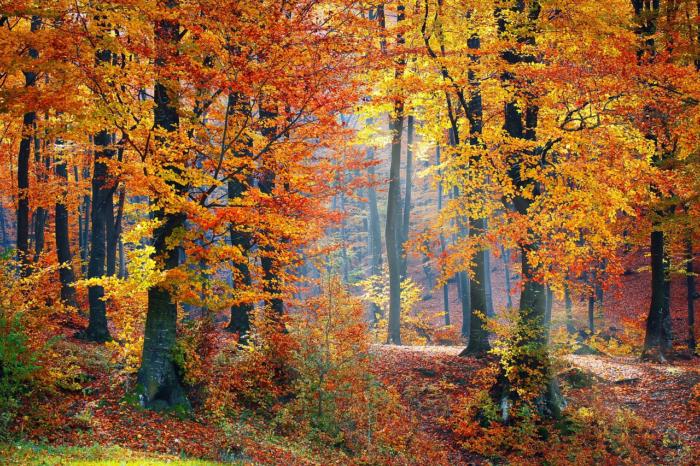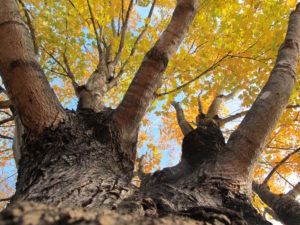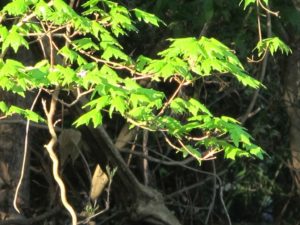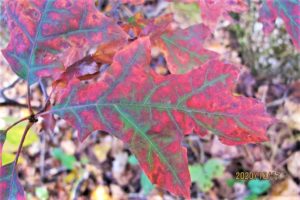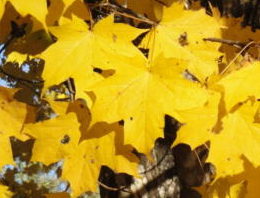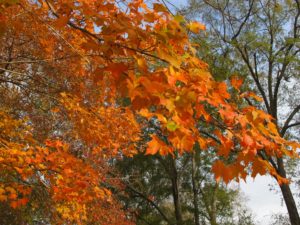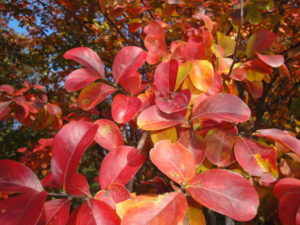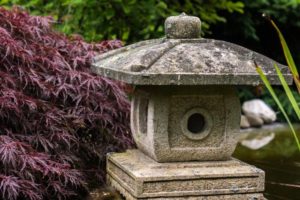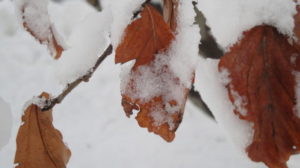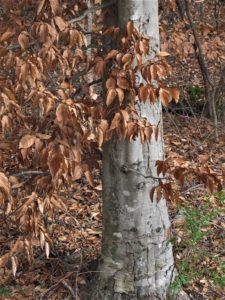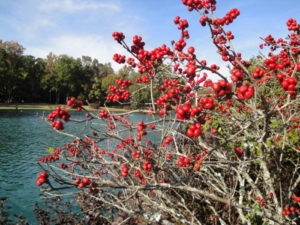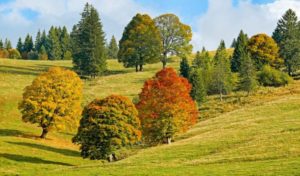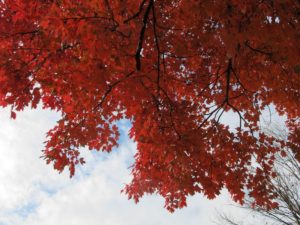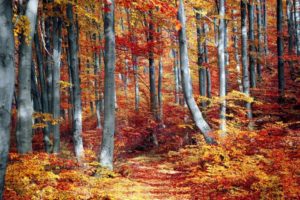One of the most phenomenal transformations in nature occurs in autumn when leaves take on fall color.
Deciduous tree canopies change from shades of green to the reds, oranges, yellows, browns, and purples associated with this time of year. A drive along the Blue Ridge Parkway, or even a glimpse out the window to the Japanese maple in the courtyard, elicits feelings of delight and wonder.
Equal to the spectacle unfolding in front of us, as we watch colors brighten from day to day, is the curiosity for an explanation. Why does fall color happen?
Plant Pigments and Fall Color
It all starts with plant pigments, which give leaves their color.
Sandwiched between a leaf’s upper epidermis and the lower epidermis is a layer of cells called the mesophyll. The mesophyll is composed of the upright cells of the palisade layer, near the surface of a leaf, and the more loosely arranged spongy mesophyll. Both kinds of cells within the mesophyll contain chloroplasts, with chlorophylls “a” and “b”. Also present within the leaf is a network of vascular tubes—phloem and xylem—which carry water and nutrients between the leaves and the roots.
These chlorophylls absorb wavelengths from different parts of the spectrum. Chlorophyll a absorbs violet-blue and orange-red wavelengths, and chlorophyll b absorbs blue light. All plants have “a” but not all plants have “b”. In lower light levels, “b” more efficiently absorbs energy from available light and transfers that energy to “a”.
In autumn, as chlorophyll degrades into transparent compounds, the carotenoids become the dominant colors. Those pigments were there all along, but the green chlorophyll masked them. We don’t see the oranges and the yellows until the greens begin to die down.
Chlorophyll
The green pigment is the familiar chlorophyll. We see it every day as plants grow and produce foliage. Chlorophyll, contained within a cell’s chloroplast, is responsible for manufacturing sugars during photosynthesis. Carbohydrates, made from oxygen and hydrogen in water, and carbon from carbon dioxide, permit growth and development of the plant. Chlorophyll is continually depleted and replenished throughout the season.
We see green leaves because most of the green wavelengths in light are not absorbed but are reflected instead. Chlorophyll pigments absorb primarily red and blue wavelengths.
Changes occur in late summer as days shorten and temperatures drop. Cells at the base of the leaf’s petiole, where it attaches to the stem, begin to cut off the vascular system. Water and nutrients no longer move freely between the leaves and the stems. Production of new chlorophyll stops, revealing the yellows and oranges. Sometimes the leaf veins are the last parts to change color and remain green as the rest of the leaf turns color (photo, above).
Carotenes and Xanthophylls
Carotenoids are composed of xanthophylls and carotenes. These are the yellow, orange, and brown shades seen in plants and animals—daffodils, corn, buttercups, bananas…and canaries, egg yolks, shrimp, fish, and flamingos. These pigments absorb wavelengths from the blue and some of the green parts of the light spectrum, which chlorophyll can’t absorb efficiently.
Xanthophylls and carotenes protect foliage from oxidative stress (cell damage) during photosynthesis. When the tree is exposed to strong sun, carotenoids absorb excess energy from excited chlorophyll molecules and release it as heat. In autumn, carotenes protect leaves as the nutrients are withdrawn from the leaves to the stems. The tree will re-use these nutrients when new foliage emerges in spring.
Beta-carotene, lycopene, lutein, and zeaxanthin are more carotenoids, present in leafy greens, fruits, and vegetables. These pigments are good for plants and for us, too—in squash, sweet potatoes, tomatoes, colorful ripe peppers, carrots, oranges, apricots, and grapefruit.
Between 15 and 30% of tree species have yellow or orange fall color. Trees that turn these colors include hickory, ash, redbud, yellow poplar, birch, aspen, black cherry, sycamore, maple, fringe tree, cottonwood, sassafras, Parrotia, pomegranate, alder, ginkgo, witch hazel, and Katsura.
Red twig dogwood ‘Arctic Fire’ and yellow-twig dogwood ‘Flaviramea’ stems turn color in cold weather and good sun. Cut back the plants in late winter, almost to the ground, to encourage a multitude of young twigs that will take on color later that fall.
Brown is often the color of cell walls and can appear in the absence of other pigments. Sometimes, leaves turn brown without turning color as a result of an early freeze. A Japanese maple that normally turns red in autumn, for example, can turn brown when the temperature suddenly plummets. Also, a tree that has been cut down in late summer or fall will turn brown instead of displaying its usual fall color. More on that later, under marcescence.
Anthocyanins
What about the red colors? Unlike the yellows and oranges, the red pigments, called anthocyanins, are produced in the sap when sugars break down in bright light.
This happens after some of the chlorophyll has degraded in autumn and as phosphate levels decrease. Phosphates break down sugars manufactured by chlorophyll in the summer in order to carry out cell activities. However, in the fall, phosphates and other nutrients move from the leaves to the stems.
You might notice that in some years, the red colors are more vibrant than in other years. Rich red colors are visible when anthocyanins are produced in greater quantities. Bright sunny days and cool but not freezing temperatures foster the blazing displays we look forward to each year.
Nutritionists encourage us to “eat all the colors” of vegetables, greens, and fruits. Anthocyanins, among the most powerful antioxidants, are found in many fruits and vegetables, including apples, cranberries, blueberries, strawberries, blackberries, cherries, grapes, plums, and red lettuce.
Carotenoids can combine with anthocyanins to form deep orange, scarlet red, and bronze fall colors.
In temperate regions, about 10% of the trees turn red or burgundy. But the percentage can be as high as 70% in areas such as New England. Some plants with predominantly anthocyanin pigments include maple, oak, sweet gum, tupelo, sourwood, dogwood, cherry, and persimmon. Purple-leaved cultivars of smokebush and redbud turn deep red in autumn.
Variety Selection in Your Landscape
When choosing shrubs and trees for your landscape, be sure to ask the nursery about fall color. There could be several cultivars within a species, each with a different color in autumn.
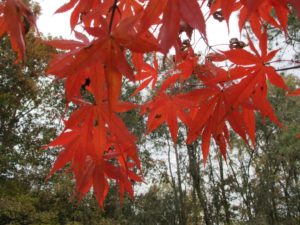
Japanese maple.
Japanese maple (Acer palmatum), for example, comes in many varieties. Red-leaved cultivars of this tree seem to be the preferred choices among customers. Foliage that remains mostly red all summer will gradually deepen to a rich reddish burgundy. And then it suddenly looks as though the plant is on fire, turning bright red. On the other hand, green-leaved cultivars can be multi-colored in the fall, or rich orange, or sunny yellow. It just depends on the cultivar.
If you’re looking for a specimen tree, and fall color is a factor, visit garden centers and public gardens in autumn when the trees show fall color. Research the full botanical names (Genus, specific epithet, and ‘Cultivar’) of the varieties you like.
This is not a guarantee, however, that young potted trees will have the same fall color as established trees. Plants in nursery pots can behave differently than plants in the garden, so take that into consideration.
Fall Color Might Depend on Weather
Seasonal weather conditions also affect a tree’s fall color. In the Maryland garden, a Parrotia persica grew in an island bed. The leaves of this witch hazel relative often turned a bright yellow color. In other years it was amber-gold, and, more rarely, salmon-red.
Prolonged mild fall weather also affects the display. That Parrotia (photo, above) occasionally held its leaves until December. Many oak species keep their orange, russet, rich red, or brown leaves through early winter before shedding them.
Red fall color is particularly dependent upon weather conditions. In 2018, trees that normally turned brilliant red were rather dull here in Charlotte. The heavy rains, high winds, and overcast weather did not promote the production of anthocyanins.
Hormones and Abscission
Abscisic acid (ABA), produced in terminal buds, slows growth and signals the plant to produce bud scales that protect the buds over winter. ABA is also produced in the root system and is translocated to the leaves during drought in the growing season, signaling the leaves’ stomates to close. This reduces transpiration, conserving water content in the plant.
Hormones produced in leaves and in the tips of twigs influence development of the abscission layer. This layer is a few cells thick, characterized by short cells with thin walls, and sits between the base of the leaf stem (petiole) and the twig. During the growing season, higher levels of auxin regulate the influence of ethylene, two hormones, resulting in the leaves’ ability to remain attached. Auxin levels fall in autumn, however, exposing cells in the abscission layer to the effects of ethylene, which promotes leaf detachment.
Cells between the petiole and the twig are differentiated, disintegrating on the leaf end and depositing lignin and suberin on the twig side. This layer of cells is weakened, causing the leaves to fall off by their own weight or with help from wind and rain. Enzymes, such as pectinases, help the process by breaking down cell walls.
Remaining on the twig is a leaf scar, with remnants of vascular strands. Over several days, lignin (tough woody tissue) and suberin (corky bark tissue) will seal the fresh leaf scar, protecting it from infection and desiccation.
Marcescence
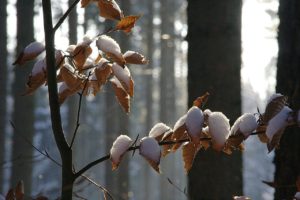
Beech tree.
Oaks (Quercus spp.) sometimes remain in brown leaf until early spring. Beech trees (Fagus grandifolia) can be spotted in the winter forest by their tan leaves dangling from the branches. Leaf retention through winter is called marcescence. The reason for this trait is open to speculation.
Nutrient Release
One theory claims that, by holding onto its leaves until new foliage is about to sprout, those newly fallen leaves will stay near the tree’s root system instead of blowing away in the winter winds. Since they have yet to begin decomposition, the nutrients locked inside the leaves will be released at a time when they can benefit the tree—when growth resumes in spring.
Browsing Animals
Another theory indicates that browsing animals are less likely to feed on marcescent twigs. In studies where deer were presented with both marcescent twigs and leafless twigs, they chose the leafless twigs.
Weather Abatement
Maybe the dead leaves help slow down fierce winds, protecting the buds from drying out. Even better is the accumulation of snow, as in the photograph (above) of a beech tree, decreasing exposure even more.
Another possibility is the protective shade cast by marcescent twigs on thin-barked trees, such as beech (photo, below). Large differences in temperatures, between night and day, can damage tissues on the south or southwest side of the trunk. Frost cracks and sun scald can be minimized when the trunk is partially shaded by brown leaves during the warm hours of the day.
If cracks occur, callus tissue will seal them, and healthy bark will compartmentalize the wound. There’s no need to paint it with “wound sealer” products. And never fill the cracks or hollows with concrete or dump rocks and debris at the base of a tree!
When a severe early frost suddenly kills a tree’s foliage, the abscission layer would not have had enough time to mature. Consequently, leaves can cling until those cellular changes occur. Young oak trees might exhibit this feature, but it often disappears with maturity. Sometimes only parts of the tree have leaves that cling.
You might have noticed that trees felled in the summer often hold onto their brown leaves.
Why Do Leaves Fall Off?
For a plant to keep its leaves all year long, resources would have to be consumed at a time when they are less efficiently gathered. When light levels are less than optimal, and cold temperatures suppress metabolic processes, it’s easier for the plant to reabsorb nutrients and drop leaves. Water loss, insect predation, foraging animals, and damage from ice, snow, and high winds are some reasons why it just isn’t worth staying in leaf through the winter. The cost is too great.
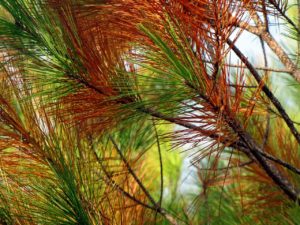
Pine tree with aging needles.
Conifers, on the other hand, have adapted to those conditions, and are able to photosynthesize all year. But they do slow down in cold weather. And the sticky sap in some species (pines, spruce, fir, and others) effectively fends off animals and most insects.
Evergreens drop some of their foliage each year; needles don’t cling forever. Some homeowners are alarmed when they see a large percentage of brown needles fall to the ground. That’s normal, as long as the tips of the stems remain green. A pine needle carpet is an effective mulch.
Protective Red Fall Color
Scientists have long speculated on the merits of anthocyanins—the red and purple pigments. Those adhering to the Photoprotection Theory claim that anthocyanins protect leaves from harmful effects of light. This pigment also helps the tree absorb nutrients more efficiently in cooler conditions, before leaf drop.
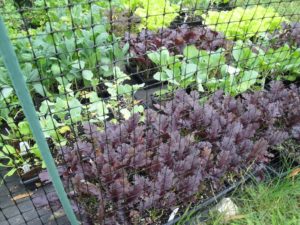
‘Miz America’ mustard greens and other brassicas.
Coevolution Theory claims that insects avoid feeding on leaves high in anthocyanins. The red fall foliage color signals them to stay away, but red berries signal birds to come and feast. (***Update***: Growing many flats of colorful fall greens illustrates this point. Among brassicas [mustard, kale, broccoli, cabbage], the deep reddish burgundy ‘Miz America’, one of the mustard greens, is entirely free of damage from caterpillars that ravage green varieties in this group. 10/7/2022)
Dogwood trees, hollies, barberry, and pyracantha have red berries that attract birds. After consuming them, the animals help distribute the seeds. Poison ivy has whitish berries that birds eat, but its foliage is fiery red, signaling birds to come around.
Red colors in some species of maple trees are produced by a different metabolic process than through chlorophyll breakdown. These anthocyanins aid in preventing competition with the tree’s own offspring by stunting the growth of saplings trying to grow nearby. This is one type of allelopathy.
But Only Part of the Tree is Turning Color
You might have noticed that a portion of a tree is prematurely turning color while the rest of the tree is still green. I’m not referring to an even coloring at the ends of branches, but rather to the one branch that is conspicuously different in color from the rest of the canopy. That branch is stressed…
- on the side of the tree where the roots are exposed to hot sun and poor, dry soil, such as on a south-facing slope (northern hemisphere).
- from root compaction.
- due to root disturbance, from working in the soil under the tree, severing roots.
- because it’s heavily shaded and not contributing to photosynthesis.
- from the tree being coppiced, or cut back to the ground. As several stems regrow, the dominant ones interfere with the others. Weaker stems will show early color and die.
- due to girdling roots. Maple trees are notorious for this. Look for and sever a root that crosses over the base of the trunk. The trunk will try to grow over the root, but could end up being constricted. Look up from that point, and you might see branches that are developing early fall color. One indication of a girdling root is the absence of an even flare all around the base of the tree. One side of the trunk will look flat where it enters the ground.
- from clotheslines, hammock ropes, or other items tied around the trunk or branches, eventually girdling the stem.
- where lightning or physical damage stripped bark off the side of a trunk, killing parts of the tree above the damage which no longer receive water and nutrients.
- from insects and diseases causing disruption in the flow of water and nutrients, affecting parts or all of the tree canopy. This can happen at the base of a leaf, a twig or branch, in the trunk, or in the roots.
Fall Color and Species Distribution
Some parts of the world are known for their fall color. Southern Canada, parts of the northern U.S., Scandinavia, northern and western regions of Europe north of the Alps, the Russian Caucasus region, Japan, parts of China, the Korean peninsula, Argentina, Chile, southern Brazil, and New Zealand’s South Island are some.
Certainly, there are pockets in millions of places around the world with absolutely dazzling fall displays! One option is to create your own by including in your landscape a few specimens with spectacular fall color.
In this country, changes in color begin as early as September in the higher elevations of the Rocky Mountains, far north Minnesota, and upper New England (far north New York state, Vermont, New Hampshire, and southwest Maine). Southern states, part of the Atlantic coast, and the California interior between mountain ranges begin their autumn displays in November. Check out this map, where you can see how fall color progresses throughout the country.
Speaking of Cold
North America is home to a diverse habitat of 800 species of trees, including 70 oaks. Northern Europe has fewer—51 species, 3 or which are oaks. These numbers do not include cultivars of the species. One thing scientists can agree on: they can’t agree on the number of tree species inhabiting the planet. Some say the number is 10,000, and others estimate over 100,000 species.
During the Ice Ages, North American tree species in southern regions and along the north-south mountain ranges were spared extinction caused by glaciers. As glaciers expanded from the north, trees were able to find refuge farther south of their original range. This took place over thousands of years. The last Ice Age occurred from 18,000 years ago to approximately 12,000 years ago.
However, in Europe, glaciers covered a larger area of land. The Alps acted as a massive barrier to species trying to retreat toward southern latitudes. Those trees were cornered, and then covered up by mile-thick sheets of ice, causing mass extinctions. This explains the disparity in the number of tree species between North America and Europe.
At the height of the last Ice Age, about 18,000 years ago, glacial ice covered one third of the planet’s land surface. Today, about 10% of the land is covered by ice.
Fall color is nature’s last hurrah of the season.
I hope you’ll consider planting trees and shrubs that have brilliant autumn color. If you’re not planning to do any landscaping, you can still enjoy the colors of autumn by visiting parks and public gardens, or by taking a leisurely stroll through the neighborhood. Maybe it’s time for a road trip. Don’t forget the camera!
